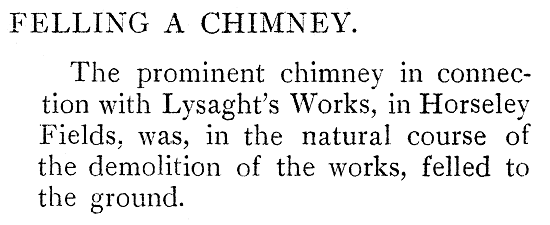| Osier
Bed Iron Works This was
situated at the northern end of Wolverhampton’s
iron-making district and traded under the name of
the Osier Bed Iron Company. It began life in the
early part of the 19th century alongside
the Wyrley and Essington canal, and had two canal
basins. By 1873 there were 4 blast furnaces, 26
puddling furnaces, and 6 mills and forges. The
factory produced large quantities of tin plate.
In 1843 William
Hanbury Sparrow, an iron master, mine owner, and
industrialist, purchased the business. He was soon
joined by his eldest son William Mander Sparrow who
became senior partner. He took complete control in
1867 when William Hanbury Sparrow died. The Sparrow
family had several houses including Penn Hall, Albrighton Hall,
and Acton Beauchamp Manor.
Two other family members, William Brown and
Thomas Fowke, joined their uncle William Mander
Sparrow as partners. Unfortunately the recession in
the iron trade in the late 1870s took its toll on
the business, and it closed in the early 1880s. |
 |
|

Casting iron 'pigs' on the
factory floor.
Rebirth
John Lysaght, a clever and
ambitious Irish businessman owned several steelworks
including factories in Bristol and Scunthorpe,
producing galvanised sheet steel, and galvanised
corrugated steel. In the early 1880s he decided to
expand into the Black Country and purchased the
Osier Bed Iron Company and Swan Garden Iron Works.
It’s likely that Lysaght purchased the Wolverhampton
factories for their rolling mills.
|

An advert from 1892. |
The business prospered, and so
the Wolverhampton factories must have been extremely
busy. Unfortunately Lysaght died in 1895 at the
relatively young age of 63. The company took the
decision to build a new steelworks at Newport in
South Wales and move their Wolverhampton business
there.
As a result the move to Newport took place in
1897, after which Osier Bed Ironworks and Swan
Garden Ironworks were closed.
It appears that most
of the Wolverhampton workforce was transferred to
Newport.
The Wolverhampton factories seem to have
remained in the possession of John Lysaght Limited
for several years because they are listed in the
1902 Red Book as still being in the company’s
ownership. |
After John Lysaght’s death the
employees at Swan Garden and Osier Bed paid for the
erection of the Lysaght memorial clock tower in East
Park as a tribute to their late employer.

A 19th century rolling mill in
operation.
| John Lysaght’s factory was demolished
March 1906 as can be seen from the cutting
below, dated 20th March. It is from the
Wolverhampton Journal. |


Osier Bed works
site was acquired by the Wolverhampton Steel and Iron
Company. In 1935 Welsh industrialist Alfred Kieft
and his son Cyril purchased the factory. They also
owned Monmore Green Rolling Mills Limited in
Wolverhampton, Haybridge Steel in Wellington, and
the Shropshire Iron and Steel Company Limited. In
1946 the four companies were combined under the name
of the Wolverhampton Steel and Iron Company (1946)
Limited. Cyril Kieft became Managing Director but
sold his interests in the company before the end of
the year because he feared that he would become a
civil servant when the industry was nationalised.
Nationalisation
took place in 1949 with the formation of the British
Iron and Steel Corporation. At the time the
Wolverhampton Steel and Iron Company produced 1,000
tons of steel each week and had 2 rolling mills, a
test house, and a laboratory. Products included
steel bars for bright drawing, machining and
forging. |
|

An advert from 1953. |
By 1953 the
company became one of the largest re-rolling
operations in the Midlands and produced around
1,200 tons of finished steel each week.
The rolling
mills were fed from continuous reheating
furnaces that could heat billets from 2 to 4
inches square. The factory had cold
straightening, reeling, and re-shearing
facilities.
A wide range
of steel sections were produced, including steel
bars up to 30 feet long, by a 9 inch guide and
merchant mill, and a 12 inch merchant mill. They
were used in the following industries:
Drop
forging, bright drawing, fencing, glazing, steel
barrel making, aircraft manufacturing, vehicle
wheel rim making, and many others.
Other products included
mild steel with a precise carbon content
(specified by the customer), free cutting and
load bearing steels, special forging quality
steels, and many alloys. |
|
The company operated in
conjunction with its associate, Birchley Rolling
Mills Limited of Birchfield Lane, Oldbury.
By 1956 both companies had
amalgamated to form Wolverhampton and Birchley
Rolling Mills Limited with their head office at
Osier Bed Works.
The combined output of both
factories was up to 2,500 and 3,000 tons of
finished steel per week. The total annual output
exceeded 100,000 tons.
In more recent years the
Osier Bed factory became British Steel Tubes
Division, Wolverhampton. The recession in the
steel industry in the 1990s and the lack of
demand for small seamless tubes resulted in 520
job losses in September 1995.
In October 1999 British
Steel changed its name to Corus after being
taken over by an Indian company.
The Wolverhampton factory
became Corus Engineering Steels’ Midland Service
Centre. |

An advert from 1959. |
| A final blow came in January 2009 when it
was announced that Corus would close the
Horseley Fields factory, which now has an
uncertain future. This is a sad end to one of
the area’s longest surviving steelworks. |

The factory in August 2009.
 |
Return to the Canals
and Industry Menu |
|